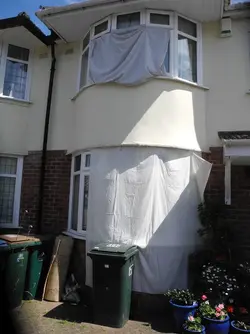1 How do guinea pigs regulate their body temperature?
2 Heat stroke: symptoms and treatment
- Symptoms of overheating (heat exhaustion)
- Symptoms of heat stroke
- On the spot treatment for heat stroke
- Persistent loss of appetite and lethargy in the days after
3 Fly strike and flesh eating maggots
4 What can I do to keep my guinea pigs cool?
- Give long-haired guinea pigs a short summer haircut
- Bring your guinea pigs indoors during the hot hours of the day (over 25 C / 77 F)
- Where can I put my guinea pigs indoors if I don't have a cage?
- How can I keep my home as cool as possible?
- How can I additionally cool down a cage?
5 How do I feed guinea pigs in hot weather?
- Crucial access to cool water at all times
- Veg and fruit
6 Where to ask questions and get illness support
- Hot weather care questions and feedback thread
- Support for heat related health issues
- Acute heat stroke/exhaustion and fly strike
1 How do guinea pigs regulate their body temperature?
Guinea pigs have evolved to live in groups in thick grasslands in the lower Andes in South America. They come out to browse in part of their territory in the early mornings and evenings when temperatures are at the their least extreme. During the days and nights they retire to abandoned deep temperature controlled sets, tunnels and thick ground covering vegetation well away from the extremes of heat or cold.
Guinea pigs regulate their body temperature via increased blood flow in their ears.
They do NOT pant and they do NOT sweat!
Because they are not losing a lot of water in order to keep cool means that they do not suddenly need a lot more water and veg in hot weather to avoid dehydrating, unlike sweating humans or panting dogs.
However, because guinea pigs cannot adapt as easily to quickly changing temperatures and the extremes of weather, they need a stable environment away from too much heat and cold and big temperature swings.
Key to keeping your guinea pigs cool does NOT require lots of water and watery veg.
But it is ABSOLUTELY VITAL to keep your guinea pigs and their water supply as cool and as fresh as you can to prevent overheating!
Guinea pigs that are born in hotter countries adapt to generally hotter conditions, but they still struggle with the seasonal heat and are very susceptible to sudden cold spells. You often see guinea pigs flopping on their bellies on the floor of their cages in the heat of the day in 'cute' pictures from tropical or subtropical countries showing signs of being overheated.
Please be aware that hot weather is worse for the very young, the very old, pregnant and nursing sows (pregnancy toxaemia!), the ill or frail and those that have an undiagnosed underlying problem. They will need extra attention and care, as much as you can give.
As a rule of thumb: Guinea pigs are fine if you are comfortable.
If it feels hot for you, your guinea pigs are already overheating!
If you are cold and want to grab a coat, your guinea pigs are also cold.
Here is a video of how quickly temperatures rise in a hutch in full sun.
(with permission of Cavy Central Guinea Pig Rescue, Sydney)
A vet is demonstrating in this video just how quickly and how hot it gets in a small confined space on a not particularly hot and breezy day and with the car windows cracked.
He will also tell you what he is experiencing during this time and how it will feel to your pets that are confined in a hot space.
This could be your hutch, conservatory, your lawn run or indoors room in full sun, too!
40 C = ca. 100 F
50 C = ca. 120 F
2 Heat stroke: symptoms and treatment
- Symptoms of overheating (heat exhaustion)
- Symptoms of heat stroke
- On the spot treatment for heat stroke
- Persistent loss of appetite and lethargy in the days after
3 Fly strike and flesh eating maggots
4 What can I do to keep my guinea pigs cool?
- Give long-haired guinea pigs a short summer haircut
- Bring your guinea pigs indoors during the hot hours of the day (over 25 C / 77 F)
- Where can I put my guinea pigs indoors if I don't have a cage?
- How can I keep my home as cool as possible?
- How can I additionally cool down a cage?
5 How do I feed guinea pigs in hot weather?
- Crucial access to cool water at all times
- Veg and fruit
6 Where to ask questions and get illness support
- Hot weather care questions and feedback thread
- Support for heat related health issues
- Acute heat stroke/exhaustion and fly strike
1 How do guinea pigs regulate their body temperature?
Guinea pigs have evolved to live in groups in thick grasslands in the lower Andes in South America. They come out to browse in part of their territory in the early mornings and evenings when temperatures are at the their least extreme. During the days and nights they retire to abandoned deep temperature controlled sets, tunnels and thick ground covering vegetation well away from the extremes of heat or cold.
Guinea pigs regulate their body temperature via increased blood flow in their ears.
They do NOT pant and they do NOT sweat!
Because they are not losing a lot of water in order to keep cool means that they do not suddenly need a lot more water and veg in hot weather to avoid dehydrating, unlike sweating humans or panting dogs.
However, because guinea pigs cannot adapt as easily to quickly changing temperatures and the extremes of weather, they need a stable environment away from too much heat and cold and big temperature swings.
Key to keeping your guinea pigs cool does NOT require lots of water and watery veg.
But it is ABSOLUTELY VITAL to keep your guinea pigs and their water supply as cool and as fresh as you can to prevent overheating!
Guinea pigs that are born in hotter countries adapt to generally hotter conditions, but they still struggle with the seasonal heat and are very susceptible to sudden cold spells. You often see guinea pigs flopping on their bellies on the floor of their cages in the heat of the day in 'cute' pictures from tropical or subtropical countries showing signs of being overheated.
Please be aware that hot weather is worse for the very young, the very old, pregnant and nursing sows (pregnancy toxaemia!), the ill or frail and those that have an undiagnosed underlying problem. They will need extra attention and care, as much as you can give.
As a rule of thumb: Guinea pigs are fine if you are comfortable.
If it feels hot for you, your guinea pigs are already overheating!
If you are cold and want to grab a coat, your guinea pigs are also cold.
Here is a video of how quickly temperatures rise in a hutch in full sun.
(with permission of Cavy Central Guinea Pig Rescue, Sydney)
A vet is demonstrating in this video just how quickly and how hot it gets in a small confined space on a not particularly hot and breezy day and with the car windows cracked.
He will also tell you what he is experiencing during this time and how it will feel to your pets that are confined in a hot space.
This could be your hutch, conservatory, your lawn run or indoors room in full sun, too!
40 C = ca. 100 F
50 C = ca. 120 F
Last edited:


